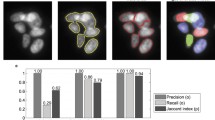Abstract
This article addresses the problem of identification of partly destroyed human melanoma cancer cells in confocal microscopy imaging. Complete cancer cells are nearly circular and most of them have a nearly homogeneous boundary and interior region. A deformable template (Grenander, 1993) is well suited for these complete cells and models a cell as a natural deformed template or prototype. We will in this article focus on the remaining cells which have lost parts of the boundary region most probably due to a 'capping' phenomenon. We can interpret these cells as being partly destroyed, where in our statistical model the lost part of the boundary region is generated by a destructive deformation field acting and living on the cell or template. By doing simultaneous inference for both the natural and destructive deformation field, we are able to obtain reliable estimates of the outline in addition to where on the boundary the cell is destroyed. We apply our model to identifying partly destroyed human melanoma cancer cells with good results.
Similar content being viewed by others
References
Baddeley, A. J. (1992) Errors in binary images and a L p version of the Hausdorff metric, Nieuw Archiefvoor Wiskunde, 10, 157–183.
Baddeley, A. J. and Van Lieshout, M. N. M. (1993) Stochastic geometry models in high-level vision, In: Statistics and Images, K. V. Mardia and G. K. Kanji (eds), Vol. 20, Chapter 11. Carfax Publishing, Abingdon. pp. 235–256.
Geman, S. and Geman, D. (1984) Stochastic relaxation, Gibbs distributions, and the Bayesian restoration of images, IEEE Transactions on Pattern Analysis and Machine Intelligence, 6, 721–741.
Gilks, W. R., Richardson, S. and Spiegelhalter, D. J. (1996) Markov Chain Monte Carlo in Practice, Oxford: Clarendon Press.
Grenander, U. (1993) General Pattern Theory, London: Chapman & Hall.
Grenander, U. and Miller, M. I. (1994) Representations of knowledge in complex systems (with discussion), Journal of the Royal Statistical Society, Series B, 56(4), 549–603.
Grenander, U., Chow, Y. and Keenan, D. M. (1991) Hands: a Pattern Theoretic Study of Biological Shapes, Research Notes on Neural Computing, Springer, Berlin.
Hurn, M. A. (1996) Bayesian image analysis in confocal fluorescence microscopy, Statistical Research Report 96:01. School of Mathematical Sciences, University of Bath, Bath, UK.
Jain, A. K., Zhong, Y. and Lakshmanan, S. (1996) Object matching using deformable templates, IEEE Transactions on Pattern Analysis and Machine Intelligence, 18(3), 267–278.
Kent, J. T., Mardia, K. V. and Walder, A. N. (1996) Conditional cyclic Markov random fields, Advances in Applied Probability (SGSA), 28, 1–12.
Qian, W. and Mardia, K. V. (1995) Recognition of multiple objects with occlusions, Stat 95/01. University of Leeds, Leeds, UK.
Rue, H. (1995) New loss functions in Bayesian imaging, Journal of the American Statistical Association, 90, 900–908.
Rue, H. and Hurn, M. A. (1997) Bayesian object identification, Statistics No. 6. Department of Mathematical Sciences, Norwegian University of Science and Technology, Trondheim, Norway.
Rue, H. and Syversveen, A. R. (1998) Bayesian object recognition with Baddeley's delta loss, Advances in Applied Probability (SGSA), Vol. 30.
Author information
Authors and Affiliations
Rights and permissions
About this article
Cite this article
Rue, H., Husby, O.K. Identification of partly destroyed objects using deformable templates. Statistics and Computing 8, 221–228 (1998). https://doi.org/10.1023/A:1008953210305
Issue Date:
DOI: https://doi.org/10.1023/A:1008953210305




